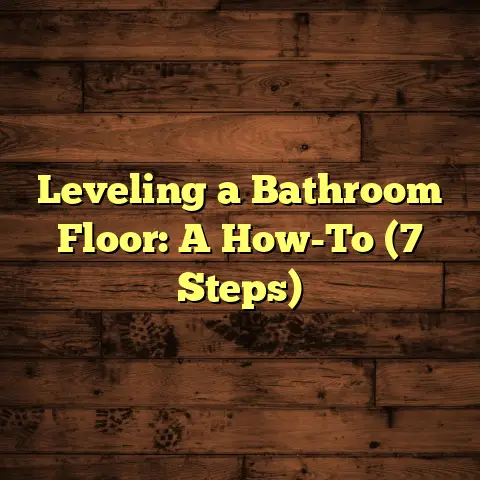Tiles Lifting? (4 Bathroom Floor Fixes ASAP!)
Yeah, lifting bathroom tiles are a real pain.
I’ve seen it all in my years as a flooring contractor.
It’s not just an eyesore.
It can lead to water damage,
mold (yuck!), and even someone taking an unexpected
tumble.
Trust me, a small slip can lead to a big
headache (literally!).
Ignoring those rogue tiles is like ignoring a leaky
faucet – it only gets worse.
We’re talking potential
structural damage and a hefty repair bill down the
line.
So, let’s tackle this head-on!
In this article, I’m going to walk you through four
fixes for lifting bathroom tiles.
We’ll cover everything
from understanding why it’s happening to getting
your hands dirty and fixing it yourself.
Ready to reclaim your bathroom floor? Let’s dive in!
Section 1: Understanding the Causes of Lifting Tiles
Okay, so why do these tiles decide to go rogue in the
first place?
It’s rarely a case of them just “feeling
like it.” There’s usually an underlying reason.
Think of your bathroom floor as a system.
Everything needs to work together – the tiles, the
adhesive, the subfloor.
When one part fails, the
whole thing can suffer.
I’ve seen it all.
Here are some of the most common culprits:
Poor Installation Practices: This is a big one.
I can’t stress enough how important proper installation is.
Did the previous installer skimp on the adhesive?
Did they properly prep the surface?- Inadequate Adhesive Application: Not using
enough thin-set mortar (the adhesive used for
tiles) or using the wrong type can lead to
weak bonds.
I’ve seen guys try to use regular construction adhesive, and it just doesn’t cut it! - Lack of Surface Preparation: Tile needs a
clean, level, and stable surface to adhere to.
If the subfloor wasn’t properly cleaned or leveled, the tiles won’t stick.
- Inadequate Adhesive Application: Not using
enough thin-set mortar (the adhesive used for
tiles) or using the wrong type can lead to
weak bonds.
-
Moisture Issues: Bathrooms are inherently damp environments, but excessive moisture is a tile’s worst enemy.
- Leaks: Even a small, slow leak from a pipe, toilet, or shower can seep under the tiles and weaken the adhesive.
- Humidity: High humidity can also penetrate through the grout and affect the adhesive over time.
- Improper Ventilation: Without proper ventilation (like a good exhaust fan), moisture builds up and creates the perfect environment for adhesive breakdown.
Substrate Problems: The subfloor is the foundation of your tile floor.
If it’s not solid, your tiles are doomed.- Concrete Settling: Concrete slabs can settle over time, causing cracks and movement that can loosen tiles.
- Plywood Movement: In wood-framed
bathrooms, plywood subfloors can flex and
move, especially if they’re not thick enough
or properly supported.
I recommend a minimum of 3/4″ T&G plywood. - Inadequate Floor Support: If the floor joists beneath the subfloor are too far apart or not strong enough, the floor will flex, leading to tile problems.
-
Temperature and Humidity Changes: Extreme temperature and humidity fluctuations can cause the tiles and subfloor to expand and contract at different rates, putting stress on the adhesive.
Real-Life Example: I once worked on a bathroom
where the tiles were lifting all around the toilet.
Turns out, there was a slow leak in the wax ring.
The
water had been seeping under the tiles for months,
gradually dissolving the adhesive.
By the time the
homeowner noticed the problem, the damage was
extensive.
Key Takeaway: Understanding the why behind
lifting tiles is crucial for choosing the right fix.
Don’t just slap some glue on it and hope for the best.
Take the time to investigate the underlying cause.
Section 2: Assessing the Extent of the Damage
Alright, so you’ve got some lifting tiles.
Now what?
Before you start tearing things up, it’s important to
assess the situation.
Think of it like a doctor diagnosing a patient.
You
need to gather information before you can prescribe
the right treatment.
Here’s how I approach assessing tile damage:
Visual Inspection: Start with a good, old- fashioned visual inspection.
- Identify Affected Areas: Where are the
tiles lifting?
Is it just a few isolated tiles, or is it a widespread problem? - Check the Grout Lines: Are the grout lines
cracked or missing around the lifting tiles?
This can be a sign of moisture penetration. - Look for Water Stains: Are there any water
stains on the surrounding walls or ceiling?
This could indicate a leak. - Inspect the Surrounding Fixtures: Check around the toilet, shower, and sink for any signs of leaks or water damage.
- Identify Affected Areas: Where are the
tiles lifting?
The “Tap Test”: Gently tap on the tiles around the affected area.
- Listen for Hollow Sounds: Tiles that are
properly adhered will sound solid when tapped.
Lifting tiles will sound hollow.
This helps you determine the extent of the problem. - Feel for Movement: Gently try to wiggle the
tiles.
If they move easily, they’re definitely loose.
- Listen for Hollow Sounds: Tiles that are
properly adhered will sound solid when tapped.
Check for Moisture: Moisture is a common culprit, so it’s important to check for it.
- Use a Moisture Meter: A moisture meter is a
handy tool for detecting moisture levels in
the subfloor and surrounding walls.
You can find these at most hardware stores. - Look for Discoloration: Check for any discoloration or staining on the subfloor or behind the tiles.
- Sniff Test: Sounds weird, but give it a sniff.
A musty or moldy smell is a dead giveaway for moisture problems.
- Use a Moisture Meter: A moisture meter is a
handy tool for detecting moisture levels in
the subfloor and surrounding walls.
-
Subfloor Inspection (If Possible): If you can access the subfloor from below (e.g., through a basement or crawl space), take a look.
- Check for Water Damage: Look for water stains, rot, or mold.
- Inspect the Joists: Make sure the floor joists are in good condition and properly spaced.
When to Call a Pro: Sometimes, the problem is
more than you can handle on your own.
Here are some
situations where I recommend calling a professional:
- Extensive Damage: If a large area of tiles is lifting, or if the damage is widespread, it’s best to consult with a professional.
- Suspected Structural Issues: If you suspect that the subfloor is damaged or that there are structural problems, call a professional.
- Mold Growth: If you find mold, it’s important to have it professionally removed.
- Unsure of the Cause: If you can’t figure out what’s causing the tiles to lift, a professional can help diagnose the problem.
Key Takeaway: A thorough assessment will help you
determine the best course of action.
Don’t be afraid
to get down on your hands and knees and really
investigate!
Section 3: Fix #1: Reattaching Loose Tiles
Okay, so you’ve assessed the damage and determined
that you can tackle the repair yourself.
Great!
Let’s start with the most straightforward fix:
reattaching loose tiles.
This is a good option if the
tiles are in good condition and the underlying problem
is simply a weak adhesive bond.
Here’s what you’ll need:
-
Tools:
- Putty knife or scraper
- Small pry bar (optional)
- Trowel (notched, to match the existing tile)
- Rubber mallet
- Sponge
- Bucket
- Safety glasses
- Gloves
-
Materials:
- Thin-set mortar (pre-mixed is easiest for small jobs)
- Grout (matching the existing grout)
- Grout sealer
- Painter’s tape
- Clean rags
Step-by-Step Guide:
Prepare the Area: Clear the area around the loose tiles.
Cover any nearby fixtures with plastic sheeting to protect them from dust and debris.Remove the Loose Tiles: This is the trickiest part.
You want to remove the tiles without damaging them.- Gently Pry: Use a putty knife or small pry
bar to gently pry the tiles loose.
Work slowly and carefully, inserting the tool into the grout lines around the tile. - Avoid Force: Don’t force the tiles.
If they’re stuck, try tapping them gently with a rubber mallet to loosen the adhesive. - Clean the Tiles: Once the tiles are removed, clean off any old adhesive from the back using a putty knife.
- Gently Pry: Use a putty knife or small pry
bar to gently pry the tiles loose.
Prepare the Subfloor: Scrape away any old adhesive from the subfloor.
Make sure the surface is clean, dry, and free of debris.Apply the Adhesive: Using a notched trowel, apply a thin, even layer of thin-set mortar to the subfloor.
The notch size should match the type of tile you’re using.
Follow the manufacturer’s instructions for the correct notch size.Re-Lay the Tiles: Carefully place the tiles back into position.
Press down firmly to ensure good contact with the adhesive.Level the Tiles: Use a level to make sure the tiles are flush with the surrounding tiles.
If necessary, gently tap them with a rubber mallet to adjust their height.-
Clean Up Excess Adhesive: Use a damp sponge to wipe away any excess adhesive from the tile surfaces.
Allow to Cure: Let the adhesive cure for at least 24-48 hours before walking on the tiles.
Follow the manufacturer’s instructions for the recommended curing time.Grout the Tiles: Once the adhesive is cured, apply grout to the grout lines around the tiles.
Use a grout float to press the grout into the lines, then wipe away any excess with a damp sponge.-
Seal the Grout: After the grout has cured for the recommended time (usually 24-48 hours), apply a grout sealer to protect it from moisture and stains.
Tips for a Long-Lasting Bond:
- Use the Right Adhesive: Choose a thin-set mortar that is specifically designed for use with your type of tile.
- Apply Enough Adhesive: Don’t skimp on the
adhesive.
Make sure you’re applying a thick enough layer to create a strong bond. - Clean the Surfaces: Make sure both the tiles and the subfloor are clean and free of debris before applying the adhesive.
- Allow for Expansion and Contraction: Leave small expansion joints around the perimeter of the room to allow for expansion and contraction of the tiles.
Key Takeaway: Reattaching loose tiles is a
relatively simple fix, but it’s important to do it
right.
Take your time, follow the instructions
carefully, and you’ll have your bathroom floor looking
good as new in no time.
Section 4: Fix #2: Addressing Moisture Issues
So, you’ve reattached your tiles, but what if the
underlying problem is moisture?
If you don’t address
the moisture, those tiles will likely lift again.
Think of it like treating the symptoms of a cold
without addressing the virus.
You might feel better
for a while, but the cold will eventually come back.
Here’s how to tackle moisture issues in your bathroom:
Identify the Source: The first step is to identify the source of the moisture.
- Check for Leaks: Inspect all the pipes,
faucets, and fixtures in your bathroom for
leaks.
Even a small, slow leak can cause big problems over time. - Inspect the Shower and Tub: Check the
caulking around the shower and tub for cracks
or gaps.
Water can seep through these cracks and get behind the tiles. - Check the Toilet: As I mentioned earlier, a leaky wax ring can be a major source of moisture.
- Consider Condensation: In some cases, condensation can be a problem, especially in poorly ventilated bathrooms.
- Check for Leaks: Inspect all the pipes,
faucets, and fixtures in your bathroom for
leaks.
Fix the Leaks: Once you’ve identified the source of the moisture, fix it!
- Repair Leaky Pipes: If you’re comfortable
doing so, you can repair leaky pipes yourself.
Otherwise, call a plumber. - Replace Worn Caulking: Remove any old, cracked caulking and replace it with new, waterproof caulking.
- Replace a Leaky Wax Ring: Replacing a wax ring is a relatively simple DIY project, but it’s important to do it right.
- Repair Leaky Pipes: If you’re comfortable
doing so, you can repair leaky pipes yourself.
Improve Ventilation: Proper ventilation is essential for preventing moisture buildup in your bathroom.
- Install an Exhaust Fan: If your bathroom
doesn’t have an exhaust fan, install one.
Make sure it’s properly sized for the size of your bathroom.
The Home Ventilating Institute (HVI) recommends at least 1 CFM (cubic feet per minute) of ventilation per square foot of bathroom area. - Use the Exhaust Fan: Make sure you use the
exhaust fan every time you shower or bathe.
Leave it running for at least 20 minutes after you’re done to remove excess moisture. - Open a Window: If possible, open a window after showering or bathing to help ventilate the bathroom.
- Install an Exhaust Fan: If your bathroom
doesn’t have an exhaust fan, install one.
Install a Moisture Barrier: In some cases, it may be necessary to install a moisture barrier to protect the subfloor from moisture.
- Waterproof Membrane: Apply a waterproof
membrane to the subfloor before installing the
tiles.
This will prevent moisture from seeping through the tiles and damaging the subfloor.
Schluter-Ditra is a popular choice.
- Waterproof Membrane: Apply a waterproof
membrane to the subfloor before installing the
tiles.
Dry the Area Thoroughly: Before re-tiling, it’s essential to dry the area thoroughly.
- Use a Dehumidifier: A dehumidifier can help remove excess moisture from the air.
- Use Fans: Place fans in the bathroom to circulate air and speed up the drying process.
- Allow Plenty of Time: Give the area plenty
of time to dry completely before re-tiling.
This could take several days or even weeks, depending on the extent of the moisture damage.
Key Takeaway: Addressing moisture issues is crucial
for preventing future tile problems.
Take the time to
identify the source of the moisture, fix the leaks,
improve ventilation, and dry the area thoroughly.
Section 5: Fix #3: Repairing Substrate Problems
Okay, let’s talk about the foundation of your tile
floor: the substrate.
If the substrate is weak,
unstable, or damaged, your tiles are going to have
problems, no matter how well you install them.
Think of it like building a house on a shaky
foundation.
The house might look good at first, but
it won’t last long.
Here’s how to repair substrate problems:
Assess the Substrate: The first step is to assess the condition of the substrate.
- Check for Cracks: Look for cracks in the
subfloor.
Even small cracks can be a sign of a bigger problem. - Check for Movement: Walk around on the subfloor and feel for any movement or flexing.
- Check for Rot or Water Damage: Look for signs of rot or water damage, especially around the perimeter of the room.
- Check for Levelness: Use a level to check
the levelness of the subfloor.
If it’s not level, you’ll need to correct it before installing the tiles.
- Check for Cracks: Look for cracks in the
subfloor.
-
Repair Cracks: If you find cracks in the subfloor, you’ll need to repair them.
- Fill Small Cracks: For small cracks (less than 1/4 inch wide), you can use a crack filler compound.
- Reinforce Large Cracks: For larger cracks, you may need to reinforce the subfloor with plywood or cement board.
-
Reinforce the Subfloor: If the subfloor is flexing or moving, you’ll need to reinforce it.
- Add Plywood: Add a layer of plywood over the existing subfloor to add strength and stability.
- Add Cement Board: Cement board is a durable, water-resistant material that is often used as a substrate for tile.
- Sister the Joists: If the floor joists are too far apart or not strong enough, you can sister them by adding additional joists alongside the existing ones.
-
Level the Subfloor: If the subfloor is not level, you’ll need to level it before installing the tiles.
- Use a Leveling Compound: A leveling compound is a self-leveling material that can be used to create a smooth, level surface.
- Shim the Subfloor: You can also use shims to level the subfloor.
Key Takeaway: A solid, stable substrate is
essential for a long-lasting tile floor.
Take the
time to assess the condition of the substrate and
make any necessary repairs before installing the
tiles.
Section 6: Fix #4: Replacing Damaged Tiles
Sometimes, tiles are just too damaged to be salvaged.
Maybe they’re cracked, chipped, or stained.
In those
cases, the best solution is to replace them.
Think of it like trying to fix a broken vase with
super glue.
It might hold for a while, but it will
never be the same.
Here’s how to replace damaged tiles:
Identify Damaged Tiles: The first step is to identify the tiles that need to be replaced.
- Look for Cracks: Check for cracks in the
tiles.
Even small cracks can weaken the tile and make it more susceptible to damage. - Look for Chips: Check for chips or missing pieces.
- Look for Stains: Check for stains that can’t be removed.
- Look for Cracks: Check for cracks in the
tiles.
-
Select Replacement Tiles: Choose replacement tiles that match the existing tiles as closely as possible.
- Match the Size: Make sure the replacement tiles are the same size as the existing tiles.
- Match the Color: Try to match the color of the replacement tiles as closely as possible.
- Match the Texture: Try to match the texture of the replacement tiles as closely as possible.
- Keep Extras: When you install new tiles, always keep a few extras on hand for future repairs.
Remove the Damaged Tiles: Carefully remove the damaged tiles.
- Grout Removal: Start by removing the grout around the damaged tiles using a grout saw or utility knife.
- Pry the Tiles Loose: Use a putty knife or
small pry bar to gently pry the tiles loose.
Work slowly and carefully to avoid damaging the surrounding tiles. - Clean the Subfloor: Once the tiles are removed, clean the subfloor to remove any old adhesive or debris.
-
Install the New Tiles: Install the new tiles using the same method as described in Section 3.
- Apply Adhesive: Apply a thin, even layer of thin-set mortar to the subfloor.
- Place the Tiles: Carefully place the new tiles into position.
- Level the Tiles: Use a level to make sure the tiles are flush with the surrounding tiles.
- Clean Up Excess Adhesive: Use a damp sponge to wipe away any excess adhesive from the tile surfaces.
-
Grout the Tiles: Once the adhesive has cured, grout the tiles using the same method as described in Section 3.
-
Seal the Grout: After the grout has cured, seal the grout to protect it from moisture and stains.
Key Takeaway: Replacing damaged tiles is a great
way to restore the beauty and functionality of your
bathroom floor.
Take the time to select replacement
tiles that match the existing tiles as closely as
possible, and follow the instructions carefully.
Conclusion
So, there you have it! Four fixes for lifting bathroom tiles.
Remember, addressing lifting tiles promptly is key
to preventing further damage and costly repairs.
Whether it’s reattaching loose tiles, addressing
moisture issues, repairing substrate problems, or
replacing damaged tiles, taking action is crucial.
Don’t be intimidated by the task.
With the right
tools, materials, and a little bit of elbow grease,
you can tackle these issues yourself and restore your
bathroom’s beauty and functionality.
And remember, if you’re ever unsure or overwhelmed,
don’t hesitate to call a professional.
We’re here to
help!
Now go forth and conquer those lifting tiles!
Your
bathroom (and your feet) will thank you.





